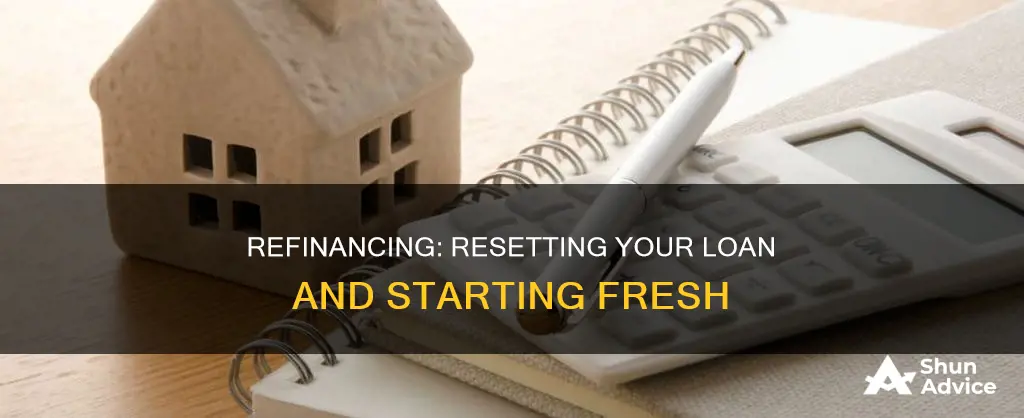
Refinancing is a valuable financial tool for homeowners who are looking to save money on their home loans. It involves moving from an existing loan to a new one, with better loan terms, interest rates and features. While refinancing can be a great way to save money, it is important to understand that it can also reset your repayment clock, especially if you sign up for a loan with a longer repayment period than what you currently have. This means that you may end up taking longer to repay the mortgage, and pay more in interest over the life of the loan.
| Characteristics | Values |
|---|---|
| Refinancing | Moving from an existing loan to a new one with better terms, interest rates and features. |
| Refinancing as starting over | Refinancing can reset your mortgage term back to 30 years or any other term chosen by the borrower. |
| Benefits | Lower interest rates, lower monthly payments, and a better alignment with financial goals. |
| Costs | Upfront fees, closing costs for the current loan, and higher interest costs over the length of the loan. |
| Considerations | Whether to maintain the remaining loan term or extend to a new term, and the total cost of the loan, including interest. |
What You'll Learn

Refinancing can reset the loan repayment clock
Refinancing can be a valuable financial tool for a homeowner. It involves moving from an existing loan to a new one, with better loan terms, interest rates and features. However, it can also reset the loan repayment clock.
When you refinance a mortgage, you are essentially replacing your current home loan with a new one. This means that the loan term may be reset to its original length, which is usually 30 years. This is a common outcome of refinancing, especially when the primary goal is to lower monthly payments. Stretching the loan over a longer period reduces the amount paid each month but increases the total interest paid over time.
For example, if you have 25 years left on your loan and you refinance to a new 30-year term, you can continue to make the equivalent of the 25-year payment. This way, you can still pay off the mortgage in 25 years while having the option to reduce payments to the 30-year schedule if needed.
It is important to note that refinancing does not always mean starting over with a new 30-year term. When you refinance, you can choose the term of your new loan. Lenders offer various terms, including 15-year and 20-year options, which result in higher monthly payments but lower total interest costs and faster repayment.
Before refinancing, it is crucial to consider the total cost of the loan, including all the interest paid over the entire term, and to use online mortgage calculators to understand the long-term financial impact of different refinance choices. Consulting a financial advisor can also help assess whether refinancing is the right decision, and what loan term best fits your financial goals.
Prosper Loan Income Verification: What You Need to Know
You may want to see also

It can reduce monthly repayments
Refinancing can be a valuable financial tool for homeowners. It involves moving from an existing loan to a new one, with the new lender paying off the old loan. This can be done with a new or current lender. Refinancing can reduce monthly repayments, but it is important to consider the full financial picture, as it may result in paying more in interest over the life of the loan.
The simplest way to lower your monthly mortgage payment is to refinance to a lower interest rate. This can reduce your payments and save you money over time, especially as rates decline. For example, if you have 20 years left on a 30-year mortgage for $300,000 at 6% interest, your payments are around $1,800 per month. By refinancing into a new 30-year loan at the same rate, your new monthly payment would be around $1,500, saving $300 each month.
However, if you refinance to a longer-term loan than you were on previously, you may end up paying more in the long run. For example, if you are 10 years into a 30-year loan, and you refinance to a new 30-year loan, it will take you 40 years in total to repay the mortgage. In this case, your monthly payments will be lower, but you will pay more in interest over time.
It is also possible to reduce monthly repayments by shortening the term of the loan. For example, if you change the term from 30 years to 15 years, your monthly payment amount will likely increase, but you will pay less interest over the life of the loan.
Another option for reducing monthly repayments is to appeal your property tax bill, shop for more affordable homeowner's insurance, or remove PMI (private mortgage insurance) to reduce your monthly housing expenses.
Private Loan Greenpath: A Smart Financial Move?
You may want to see also

But it may increase total interest paid
Refinancing can be a valuable financial tool for a homeowner. It involves moving from an existing loan to a new one, with better loan terms, interest rates, and features. However, it may also reset your repayment clock, increasing the total interest paid over the life of the loan.
When you refinance, you may be offered a new loan term, typically 25 or 30 years, which is known as resetting the mortgage term. This can result in lower monthly payments but over a longer period, leading to higher overall interest costs. For example, switching from a 25-year to a 30-year loan term can reduce monthly payments by a significant amount, but the interest cost may increase by tens of thousands of dollars over the life of the loan.
The decision to reset the loan term during refinancing depends on your financial situation and goals. If you choose to refinance with a longer loan term, you may end up paying more in total interest. This is because you will be paying interest for a longer period. For instance, if you have 25 years left on your loan and you refinance to a new 30-year term, you will be taking 40 years in total to repay the mortgage.
To make an informed decision, it is crucial to consider the total cost of the loan, including all the interest paid over the entire term. Lenders are required to provide a Loan Estimate and Closing Disclosure, detailing these figures. Using online mortgage calculators can help you understand the financial impact of different loan terms and interest rates. Consulting a financial advisor can also help assess your financial situation and determine if refinancing aligns with your goals.
Refinance Loans: Reali's Offerings and Your Options
You may want to see also

It can help access equity for renovations
Refinancing can be a valuable financial tool for homeowners. It involves moving from an existing loan to a new one, with better loan terms, interest rates, and features. When you refinance, your loan term may be reset to its original length, and you may have to pay closing costs on the refinance.
One of the benefits of refinancing is that it can help you access equity for renovations. Renovations can be expensive, and refinancing allows you to use the equity you have built up in your home to fund these improvements. This is often referred to as a cash-out refinance. With this option, you replace your existing mortgage with a new, larger loan. The difference between the new loan amount and your current mortgage balance is given to you in cash, which you can then use for renovations.
To be eligible for a cash-out refinance, you typically need to have built up a certain amount of equity in your home. The rule of thumb is that you should have at least 20% equity, although this may vary depending on the lender. It's important to note that cash-out refinances usually come with higher interest rates and associated costs.
Another option is to refinance to a mortgage program specifically designed to help pay for renovations. Freddie Mac, for example, offers the CHOICERenovation mortgage, which allows you to finance a wide range of repairs and renovations, including those to increase your home's resilience to natural disasters or to update an older home.
By using refinancing to access equity for renovations, you can increase your property's value. Renovations in certain areas, such as the kitchen or bathroom, can boost your home's overall worth. This increased value can benefit you if you decide to sell in the future and can also provide additional equity.
However, it's important to consider the potential drawbacks of refinancing for renovations. One disadvantage is that your monthly mortgage payments will likely increase, as you will be responsible for repaying a larger amount. Additionally, if you refinance to a longer loan term, you may end up paying more in interest over the life of the loan. Therefore, it's crucial to assess your financial situation and ensure you can comfortably afford the new payments before proceeding.
Exploring Quickin Loans: Chat Box Availability and Features
You may want to see also

It doesn't automatically reset to a 30-year term
Refinancing a loan can be a valuable financial tool for a homeowner. It involves moving from an existing loan to a new one, with better loan terms, interest rates, and features. However, it is important to note that refinancing does not automatically reset to a 30-year term. When refinancing, you have the option to choose the term of your new loan, and it is crucial to carefully consider the implications of your decision.
While a 30-year fixed-rate loan is the most common option, offering lower monthly payments, it also results in the longest repayment period and the highest total interest paid over time. As such, refinancing to a 30-year term may not be the best choice for everyone. For example, if you have already been paying off your loan for a significant number of years and then refinance to a new 30-year term, you may end up taking much longer to repay the loan, ultimately paying more in interest.
In some cases, borrowers may choose to refinance to a shorter loan term, such as a 15- or 20-year loan. While this option results in higher monthly payments, it can help you pay off your loan much faster and save a significant amount of money on interest. Therefore, it is important to consider your financial goals and priorities before deciding on a loan term.
Additionally, it is worth noting that refinancing can come with costs, such as upfront fees and closing costs. These fees should be carefully considered before initiating the refinancing process, as they can impact the overall affordability of the loan. Online mortgage calculators can be a useful tool to compare different loan scenarios and understand the long-term financial impact of refinancing choices.
In conclusion, while refinancing a loan can provide benefits such as lower interest rates and better loan terms, it is important to remember that it does not automatically reset to a 30-year term. Borrowers have the option to choose the term that best suits their financial goals and priorities, and it is crucial to seek professional advice and carefully consider all implications before making any decisions.
Progressive Finance Cash Loans: What You Need to Know
You may want to see also
Frequently asked questions
It depends on the terms of the new loan. Refinancing can reset your mortgage term back to 30 years, or another term of your choosing. However, you can also choose to maintain the remaining loan term.
Resetting the loan term can reduce your monthly repayments.
Resetting the loan term can mean that you pay more interest over the length of the loan.







